
Park provides refuge for at risk manatees
HOMESTEAD, Fla. – On Aug. 3, 2006, a two-week-old manatee was rescued off the coast of Grand Cayman Island.
The manatee, which is not native to Grand Cayman, would not have survived very long without its mother and all the salt water. Environmental specialists concluded the animal to be from Cuba, but it could possibly have come from the Florida Keys.
The baby manatee, named 4B after the four men who found it, was re-hydrated and stabilized before finding a new home in Lowry Park Zoo in Tampa.
Although manatees are a primary focus in South Florida, they are endangered worldwide and most manatee deaths are due to human causes.
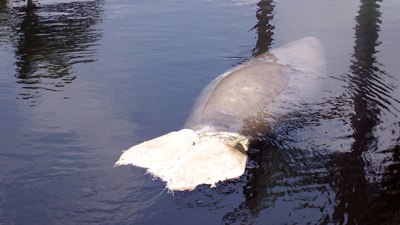 |
A Coral Gables manatee died after a propeller slashed the spinal cord and cut off blood flow to the tail (Photo courtesy of Donna Clements, Marine Animal Rescue Society). |
But protected places like the Everglades National Park, Biscayne National Park and Dry Tortugas National Park have given these endangered animals a refugee.
Everglades National Park is the largest subtropical wilderness in the United States and the area boasts many endangered animals including American crocodiles, Florida panthers and West Indian manatees.
The Everglades park has been designated an International Biosphere Reserve, which helps protect the lives of these endangered animals.
| Rescued in Key Largo, this manatee was hit by a large vessel (Photo courtesy of Donna Clements, Marine Animal Rescue Society). | 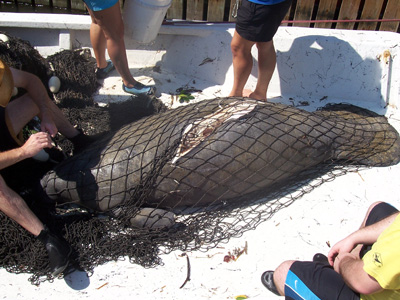 |
Brian Corroyer, who has a bachelor’s degree in fishery science and ichthyology from Rhodes University in South Africa, has dealt with these endangered sea mammals.
“The species of manatees found in South Florida can grow up to 1,000 pounds and roam in coastal waters from Louisiana to Virginia. However, a lot of manatees are found in the Everglades in the winter months because they seek the warm waters of Florida,” said Corroyer.
According to a survey conducted by the Everglades National Park, an estimated 2,223 manatees were found in the Everglades in January, 2000 and close to 3,000 are surviving today.
Manatees are peculiar animals. Their giant size can intimidate people, but they are actually quite calm and gentle animals and are very friendly. Manatees divide their time between eating, playing and sleeping.
“The Everglades are a perfect place for manatees to seek a home. They are herbivores that consume up to 15 percent of body fat per day and the Everglades have an abundance of sea grasses and aquatic plants,” said Corroyer.
Even though the Everglades provide protection for manatees, they still face many dangers. Manatee deaths are broken down into eight categories based on gross, historical and microbiological findings.
Manatee deaths are categorized as: watercraft, crushed / drowned in flood gates or canal locks, other human-related reasons, prenatal, cold stress, other natural, undetermined and verified / not recovered. However, two of the eight categories are due to human impact on the manatee population.
The Everglades has set up strict rules for boaters in the area. All motors are prohibited in freshwater lakes because manatees and other endangered animals tend to live in these areas.
Operating a water vessel at more than five miles per hour or creating wake is prohibited in the Everglades City, Flamingo and Key Largo areas.
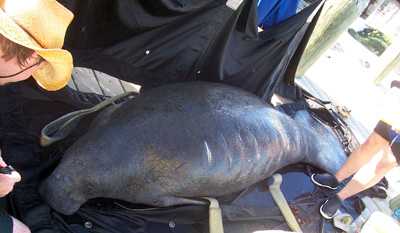 |
A manatee found at Port Everglades has propeller slashes down its side (Photo courtesy of Donna Clements, Marine Animal Rescue Society). |
Vessels towing of persons on water skis or other similar types of equipment is prohibited to ensure that manatees, as well as other marine life, are not disturbed.
Because of massive restoration and efforts to increase manatee and other wildlife population in the Everglades, their population numbers have increased.
Pamela Sweeney is an environmental specialist for the Florida Department of Environmental Protection who deals with wildlife distress on a daily basis.
“There has been much change in the manatee population because of the effects of such things as the Comprehensive Everglades Restoration Plan (CERP). One of the priorities of CERP is to change the direction of water flow in the Everglades which will restore it to how it was originally,” said Sweeney.
With original restoration it will help sea grasses and plants and therefore help manatee survival.
On Nov. 10, 2006, rangers of the National Park Service found a dead manatee in a bay near Homestead. The manatee’s throat had been cut and its flippers and other parts cut off. However, a necropsy three days later revealed the manatee was dead before it had been mutilated.
Patrick Rose, a member of the Save the Manatee Club, is a biologist as well as the organization’s executive director.
“We are partially relieved that the animal was likely dead before mutilation. It appears the manatee was already in a weakened condition and probably died of natural causes. Nevertheless, there are no words to describe how upsetting the subsequent mutilation was to us and to many manatee supporters in Florida and around the world,” Rose stated in a recent press release from club.
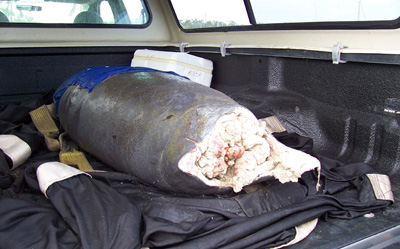 |
A mutilated manatee is taken for examination (Photo courtesy of Donna Clements, Marine Animal Rescue Society). |
Before the incident, Rose had been worried of increasing boat traffic and the loss of habitat in conjunction with loss of long term survival in manatees.
“Although we are greatly saddened each time a manatee is killed by collision with a boat, the leading cause of manatee deaths, we know that most boaters care about manatees and would not intentionally try to kill them,” Rose said.
Even though the leading cause of death among manatees is boating the Everglades is actively trying to protect them by enforcing strict rules.
In 2005 statistics compiled by the Fish and Wildlife Research Institute reported six manatees were killed in Broward, Miami-Dade and Monroe counties by watercraft.
Throughout 2005, 396 manatees were reported dead in the state of Florida.
From January to October 2006 mortality throughout the state was at 336 and only one manatee death in Miami-Dade County was watercraft related.
“The precautions taken by Everglades’s personnel have most definitely increased the survival rate of manatees living in the Florida Bay. Certain organizations out there creating awareness of manatee death and that also contributes to their survival rate. We can never spread the word too far,” said Corroyer.
| A manatee’s pec fin wrapped in fishing line. (Photo courtesy of Donna Clements, Marine Animal Rescue Society). | 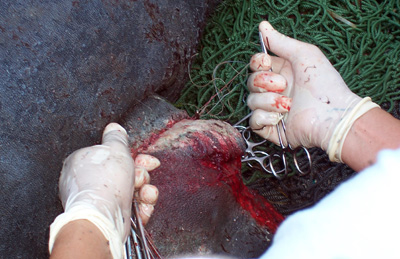 |
Everglades National Park officials have taken an active stance to decrease manatee death due to human-related conditions.
However incidents still happen and because manatees are listed on the endangered species list by U.S. Fish and Wildlife Service convicted perpetrators can face up to a year in prison and / or $100,000 fine for violating the Endangered Species Act.
For More Information
The National Park Service is asking anyone with information on the manatee found Nov. 10, 2006 to call 305-230-1144 ext. 3067.

Comments are Closed